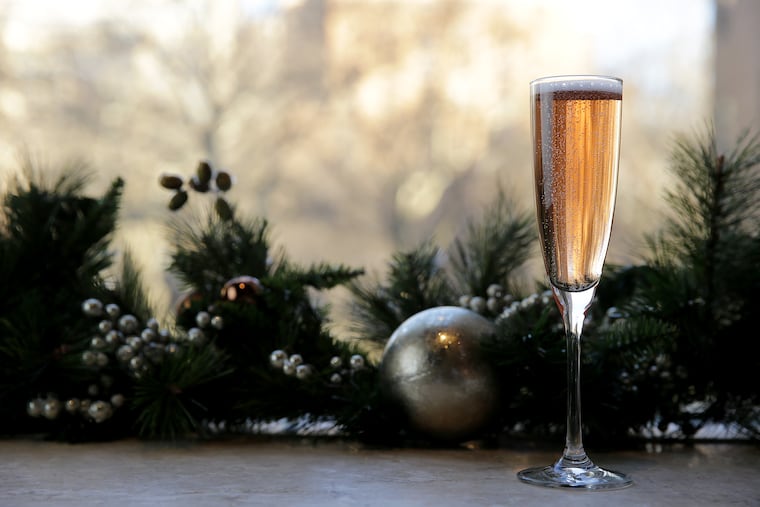Why Champagne makers are popping more corks this year
The 2018 harvest of Champagne grapes is looking like the best in years, experts say. That means future bottles of bubbly will taste even better.

Heavy rain swept across France last winter, soaking the ground and overflowing rivers to their highest levels in decades. Eventually, the clouds cleared to usher in a historic heat wave, and sometime in the summer, the stars aligned above the Champagne region.
Instead of decimating the grape crops in Champagne, the extreme weather created a perfect storm of conditions that produced what some Champagne growers say is the best harvest in a decade.
Experts say that bounty is good news for fans of bubbly in Philadelphia and around the world.
“It’s looking like 2018 has turned out to be off the charts in terms of quality and quantity,” said David Moore of the Moore Bros. Wine Co. in Pennsauken, which sells wine made by independent growers.
Michael DeMartinis, a wine buyer for Pennsylvania Fine Wine and Good Spirits stores, said winemakers won’t know for sure how good last summer’s Champagne grapes are until they start tasting the juice in the spring. Bottles made from the 2018 harvest won’t make their way to shelves for more than a year.
“But early signs are that the fruit looks spectacular,” DeMartinis said. “The grapes look clean; there’s no mildew.”
The winemakers of Champagne were overdue for a bumper crop. Recent years brought hard rain, frost, and hail to the region, as well as to other parts of France, like Bordeaux, where some winemakers lost all of their harvests in 2017. Weather fluctuations, such as early warm spells followed by plummeting temperatures, also damaged crops. Grapes that survive such weather may be fine in terms of flavor, Moore said, but often only a small number can be harvested.
This year could have brought more of the same, with France recording some of its wettest winter months on record, then a heat wave that caused droughts across Europe. The warmth ripened the grapes faster than usual, but thanks to the water saturating the soil in the Champagne region, DeMartinis said, the vines were able to reach for a drink.
“If it hadn’t been for those hard rains, we’d be looking at a very different situation," he said.
An early-fall statement from the Champagne growers' union announced “an exceptional wine-growing year,” and noted that the harvest had begun in August — only the fifth time in the last 15 years it had started so early.
Samantha Germani, sommelier at Lacroix Restaurant in the Rittenhouse Hotel, said those who work in wine sales are learning to embrace the unpredictable nature of farming. Last year, weather problems led some Champagne houses to allocate only a limited number of bottles to Pennsylvania. In 2019, she expects to receive a much larger stash.
“Global warming is horrible, but for very specific crops, and some years, it can be very beneficial,” she said.
Champagne by definition is made only from grapes grown in the Champagne province. Other effervescent drinks, like prosecco, cava, and lambrusco, are considered sparkling wines.
Most mass-produced Champagnes are cuvées, meaning they are made not solely from one year’s grape harvest, but from blends of different years taken from reserve tanks maintained by the winemakers.
“There’s maybe one that’s sweeter, one that isn’t as good, one that might be more acidic, and they take those vintages and blend them together like a chef," said Michael McCaulley, wine director for Tria restaurants.
Vintage Champagnes, made using only grapes of the same year’s harvest, are made in limited quantities. Vintage bottles can be found at major wine retailers, but many cost more than $100. When the 2018 bottles are released, they might be especially pricey, McCaulley said.
“It’s looking like this year will produce great vintage wines, but it will also produce great parts of other nonvintage blends,” McCaulley said.
Champagne houses have recently been forced to dip into their reserve tanks in order to keep manufacturing bottles of bubbly, and the bumper crop will allow producers to replenish those reserves, DeMartinis said. That means the bumper crop probably won’t lead to lower prices, but he said local consumers haven’t seemed to mind the cost: In Pennsylvania, Champagne sales have increased by 14 percent over the last year.
“Just knowing that 2018 was a good year, it will give the consumer confidence,” DeMartinis said.
When it comes to the world’s largest Champagne houses, which strive to produce bottles that taste consistently the same year after year, the individual flavor of each harvest is almost irrelevant. The real difference will be most noticeable in bottles produced by smaller growers, Germani said, whose Champagnes reflect each year’s soil, raindrops, and air.
“This will change cuvées for years to come," she said.
What to drink this holiday season
For Champagne to enjoy at home this New Year’s Eve, DeMartinis recommends:
Champagne Moutard Grande Cuvee Brut NV, $28.99, PLCB Item #48025. In addition to being a fantastic value for the price, it’s bright, with tangy acidity and notes of apple, almond, and fresh ginger.
Louis D’Or Champagne Brut NV, $34.99, PLCB Item #75634. Apple and floral aromas, soft, round fruit notes on the mid-palate, and has an elegant finish.
Ruinart Blanc de Blancs NV, $63.99, PLCB Item #29415. Creamy, and has lovely texture and complexity but still approachable and very popular.
Tria’s locations at 1137 Spruce St. and 123 S. 18th St. offer creamy-tasting Champagne Ployez-Jacquemart NV for $16 a glass. Both locations will also be pouring $10 glasses of sparkling wine from all over the world throughout the day on Dec. 31.